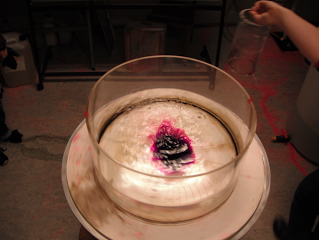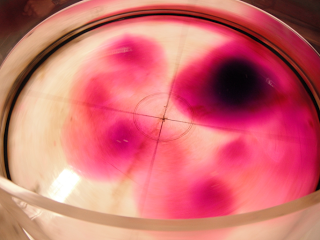
Tilting of a frontal surface under rotation
Eddy in a rotating tank.
This is an experiment that Pierre and I ran two years ago in Bergen but that – as I just realized – has not been featured on this blog before. Which is a pity, because it is a pretty cool experiment.
Under rotation, vertical fronts with different densities on either side can persist for a long time without leading to the density-driven adjustment shown in the non-rotating Marsigli experiment. This is what we demonstrate with this experiment.
In a not-yet-rotating tank, dyed salt water is filled into a centered cylinder while, at the same time, fresh water is filled in the tank outside of the cylinder.
This setup is then spun up for approximately half an hour. Then, the cylinder can be carefully removed and the column of dense water can adjust to the new conditions.
When the cylinder is being removed, disturbances are being introduced. Hence, several columns with sloping fronts develop in the rotating system.
This is what the rotating tank looks like from the side several minutes after the cylinder has been removed.
Here are a couple of movies of this experiment. First a top view (note how you can see the deformation of the surface when you focus on the reflection of the ceiling lights on the water’s surface!):
Then a side view:
And finally (just because it’s fun) this is what it looks like when you switch off the rotation of the tank when you are done with the experiment:




Tilting frontal surface under rotation / cylinder collapse - Adventures in Oceanography and Teaching says:
[…] so I’ve been practicing it today. It didn’t work out quite as well as it did when Pierre and I were running it in Bergen years ago, so if you are looking for my best movie of that experiment, you should go read the old blog […]
Collapsing column | Dr. Mirjam S. Glessmer says:
[…] whole tank has reached solid body rotation). In Bergen, we used to show this experiment as a “collapsing column” experiment, the tilting of a frontal surface under rotation. For those cases, all the […]
Hetonic explosion | says:
[…] you don’t scale your tilting of frontal surfaces under rotation experiment correctly, you get a phenomenon called “hetonic explosion”: the formation […]
Hetonic explosion | says:
[…] correctly, and then to set up the experiment accordingly. We aimed for a single column like in our tilting of a frontal surface under rotation […]
Simulations of hetonic explosions | says:
[…] whole tank has reached solid body rotation). In Bergen, we used to show this experiment as a “collapsing column” experiment, the tilting of a frontal surface under rotation. For those cases, all the […]